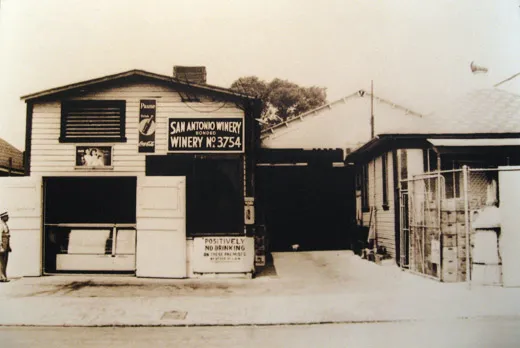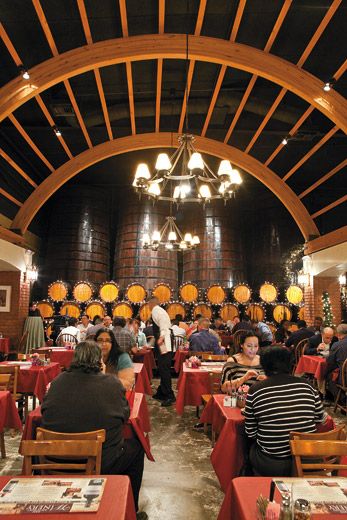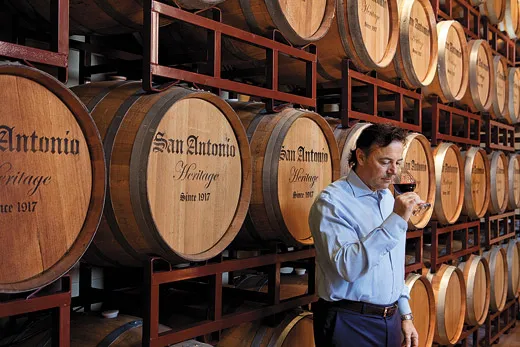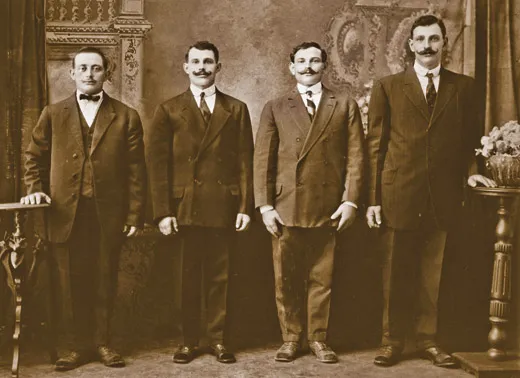Saved From Prohibition by Holy Wine
In downtown Los Angeles, a 95-year-old winery weathered hard times by making wine for church services. Now connoisseurs are devoted to it
/https://tf-cmsv2-smithsonianmag-media.s3.amazonaws.com/filer/Wine-Prayer-tank-room-631.jpg)
St. Anthony of Padua is not the patron saint of winemakers—that distinction goes to St. Vincent or St. Martin of Tours or, if you happen to be in Bulgaria, St. Trifon the Pruner—but perhaps he should be, at least in Southern California. Because when Santo Cambianica came to Los Angeles from Lombardy and founded the San Antonio Winery, it was his devotion to that saint and his church that would save the business.
Like most of his compatriots, Cambianica was a Catholic, a very devout Catholic by all accounts, and thus he named his winery after St. Anthony, the patron saint not of winemakers but of lost things, of travelers, of the poor. If Cambianica was a traveler, he did not remain so. Nor did he end up poor and lost, as so many of his fellow winemakers did, when in 1920 Prohibition slammed the wine industry like a heavy jug thudding down on a dining table.
Cambianica immigrated to downtown Los Angeles in 1914, making his home and starting his winery on half an acre of land in what was then Little Italy, a thriving network of thousands of Western European immigrants. It was then one of the largest pockets of Italian-Americans west of the Mississippi. The Italians settled in Lincoln Heights and in what is now Chinatown, coming here because of a thriving agricultural industry and because of the Southern Pacific Railroad. It was a good location for a winery, as there were vineyards in the nearby valleys, a railroad to transport the product—the Red Car Line ran just outside the doors of the winery—and plenty of wine-accustomed immigrants to drink it.
Prohibition changed the burgeoning California wine business into an industry in sudden crisis, patched together with string and wire and oak barrel slats—and loopholes. The Volstead Act, which enforced the 18th Amendment, exempted alcohol that was used for medicinal or cosmetic purposes, such as hair tonics and toilet waters and elixirs, and for religious purposes, specifically sacramental wine.
When San Antonio Winery was founded in 1917, three years before Prohibition, it was one of about 90 wineries in Los Angeles; when Prohibition was repealed, in 1933, it was one of about a half dozen. Santo Cambianica literally saved his winery in much the same way that the Catholic Church metaphorically saved its parishioners: by transforming ordinary table wine into something sacred, into the altar wine used in Mass.
That the winery had been named for a Catholic saint and that Cambianica had strong ties to the church made the transition logical from both sides, and thus the winery struck a deal to continue to make sacramental wine during Prohibition. (Many wineries already made wine to sell to churches and synagogues; during Prohibition that practice went into overdrive.)
“Most of the other brands were not spiritual; they had names like Sunny Side or Sunny Slope,” points out Steve Riboli, Cambianica’s great-nephew and now the vice president of San Antonio Winery. San Antonio “was a faith-based company,” says Riboli. “Literally.”
Cambianica quickly adapted his business to fit the situation, in itself a kind of transformative process that became emblematic for the company. Before Prohibition, San Antonio was a small winery, making about 5,000 cases of red wine, the kind of wine that was sold “family-size,” or in jug form, to local immigrants and five area churches. By the time Prohibition ended, it was producing 20,000 cases. Today, San Antonio Winery is the largest supplier of sacramental wine in the country.
If downtown Los Angeles was a logical place to build a winery nearly a century ago, it is certainly not where you would expect to find one now. The winery occupies three blocks of what is in 2012 a largely industrial horizontal landscape. The footprints of Little Italy are faint, the ghostly color of concrete: the tiny Lanza Bros. Market, which still operates up the street from the winery, and the winery itself, with its banners and carefully maintained entrance. Other than that? Nothing much is left of the bungalows and shops, the pasta makers and fishmongers that made up the thriving community.
But walk over the threshold of the winery into the vast complex—100,000 square feet of showroom and restaurant, tasting rooms and bottling facility, fermentation and aging cellars and warehousing—and you’ll find history everywhere you look. It’s in the black-and-white photos of Cambianica; of his nephew Stefano Riboli, Steve’s father, who came over from Italy in 1936 at 15 to help run the business; of Stefano’s wife, Maddalena, a tractor-driving teenager from an Italian family who had immigrated to Guasti, in Ontario, California. You can see the history in the rows of wine bottles themselves and in the enormous four-inch-thick redwood barrels, so large they could hold up to 25,000 gallons of wine, that populate the rooms like the remnants of an old-growth forest.
On a recent afternoon, Steve Riboli walked around the giant barrels touching the burnished surfaces and remembering when he played inside them—the barrels were replaced by stainless steel tanks in 1963—washing the interiors with baking soda and emerging, wine-stained and faintly pink. “We haven’t divorced ourselves from the past at all,” says Riboli. “We’ve evolved – from sacramental wine to 92-93 [point]Wine Spectator wine.”
Riboli now operates the business (“I’m the bottle washer”) with his brother Santo; Santo’s sons Michael and Anthony, one of the winery’s four winemakers; his sister Cathy and his parents, who are still active in daily operations. And they do so in the same building, albeit as vastly transformed as the operation itself.
San Antonio still makes and bottles much of the over 500,000 cases of wine it produces annually in L.A. It has another facility up the coast in Paso Robles. The grapes no longer come from Pasadena and Glendora and Burbank, but are grown on 500 acres of vineyards in Napa and Monterey counties and in Paso Robles. By the early ’60s, San Antonio had become the last winery in Los Angeles, and in 1966, it was designated one of the city’s cultural landmarks.
All that history fills the bottles of the sacramental wine that still constitutes close to 15 percent of San Antonio’s annual production. Tastes have changed through the years, as the Church has changed (the use of altar wine in Catholic services expanded after the Second Vatican Council, in the 1960s) and as its clergy and parishioners have become more accustomed to wines beyond the varieties used for religious ceremonies. Today San Antonio makes six sacramental wines, with four—a red, a rosé, a light Muscat and an Angelica—being the most popular.
Sacramental wines were once very sweet and mostly fortified—canon law stipulates that wine for the Eucharist must be “from fruit of the vine.” Riboli says that the vast majority of altar wine now is medium dry, and that his wines have no added water or sugar.
Since the early ’90s, priests and parish leaders have been asking the industry for drier wines and lighter colors. Before then, sacramental wine was dark, valued for its deep color that suggested the blood of Christ it represented. But lighter wines not only have appealed to the palates of both clergy and parishioners, they have had pragmatic value too—as lighter wines are easier to clean when they inevitably spill, and are thus less likely to stain the altar cloths. Imagine your own dry-cleaning bills after an evening of, say, pot-au-feu and Cabernet Sauvignon.
The Cathedral of Our Lady of the Angels in downtown L.A. has used San Antonio’s sacramental wines exclusively since opening and even has four different San Antonio labels in its gift shop. Monsignor Kevin Kostelnik, the pastor of the cathedral, says that parishioners buy the wine not only to drink, but as a souvenir.
Kostelnik says before the cathedral opened in 2002, it formed a wine-tasting committee to choose the sacramental wines. The committee went to nearby San Antonio for a tasting session and ultimately decided on the Communion rosé (“It’s based on palate: It was a full-bodied rosé”), which is the only wine the cathedral uses for the Eucharist. And it goes through a lot: 25 cases a month, or over 300 bottles, at a rough cost of $1,500.
“San Antonio is a treasure,” says Kostelnik. “There aren’t many urban areas that have a winery, and supporting them has been an important ministry. They’re a model of sacrifice for staying in the city.” As for the wine itself, the monsignor says that the quality of wine is important for both theological and aesthetic reasons. “We don’t use cheap wine. It’s the blood of Christ: We want to use the best wine that we can find.”
Made under canon law, San Antonio produces its sacramental wine group from grapes grown in California’s Northern San Joaquin Valley from older vines with intense flavors: the red is a blend that includes Barbera and Cabernet grapes; the rosé is made with Grenache. The Angelica is fortified with grape brandy, as was the custom with previous generations of altar wines, to achieve 18 percent alcohol.
Mercifully gone are beverages of the Prohibition days, when altar and medicinal wines were “kind of like aJägermeister thing,” says Riboli. Instead these are sacramental wines that could happily do dinner duty, maybe with a plate of the pasta that is made daily in Maddalena Riboli’s restaurant, which opened in 1974 in a former fermenting room.
“The reason we exist today is because of Prohibition,” says Steve Riboli, after threading his way through the network of barrels and cases and bottles and fermenting tanks that form his family’s universe to come to rest near his father, now 90, who is seated in the wine shop, near the door that leads out to the parking lot and, beyond that, to 21st-century L.A.
Stefano Riboli points to the concrete a few feet away and remembers the railroad that nearly came up to where his feet are now. He remembers the night he first arrived in L.A. in 1936, when his uncle showed him his “villa,” a garage with two ramshackle beds. He looks around at his business, thriving in a place where you would not have expected it to thrive, still incongruous in the urban landscape.
“We’ve endured,” says Steve Riboli.
Photographer Gilles Mingasson, a frequent contributor to Smithsonian, lives in Los Angeles.
Planning Your Next Trip?
Explore great travel deals
Smithsonian magazine participates in affiliate link advertising programs. If you purchase an item through these links, we receive a commission.



